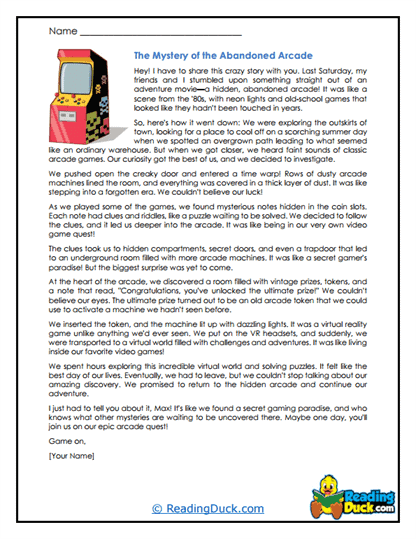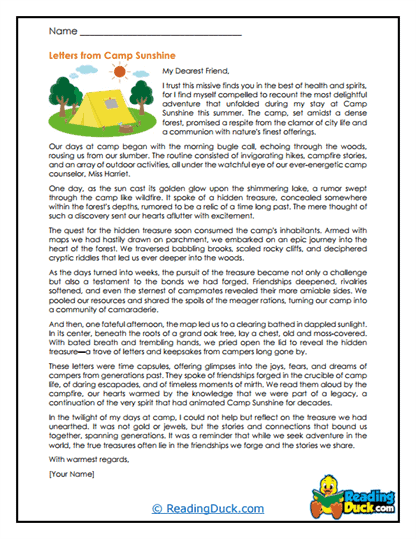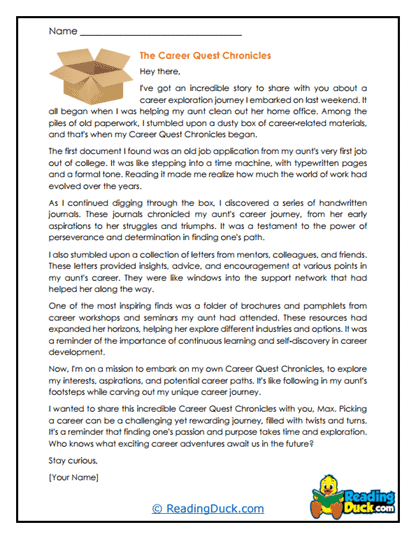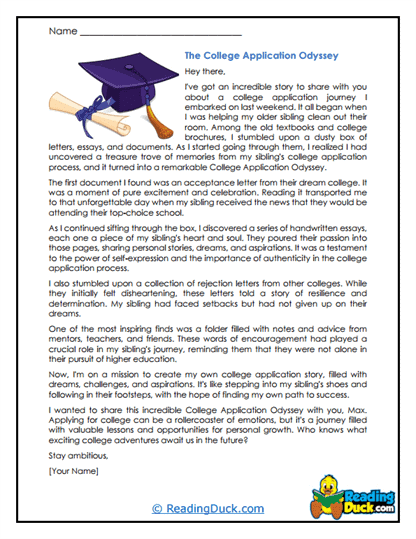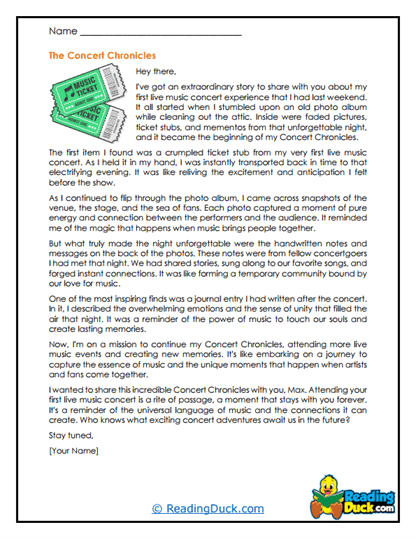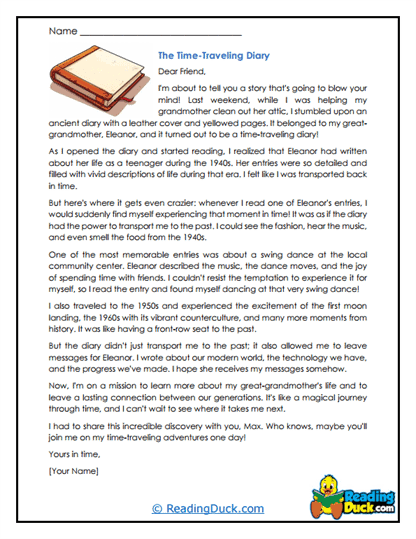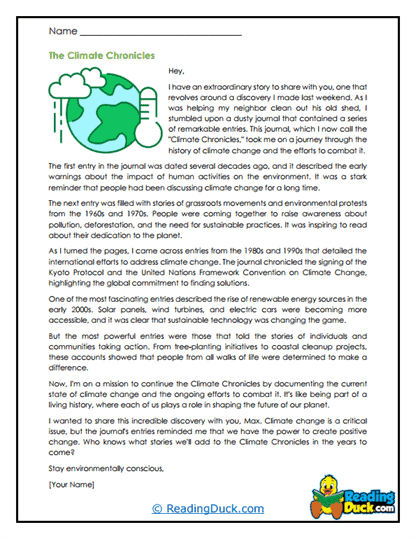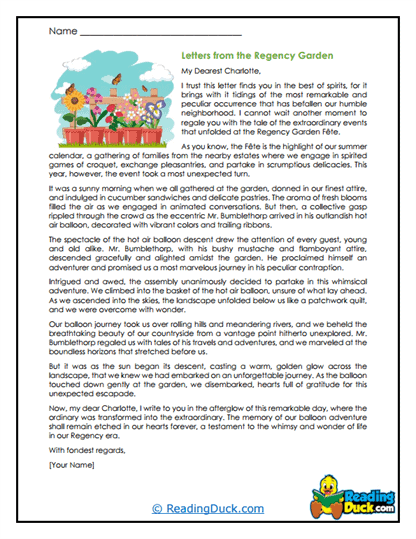Epistolary Fiction Worksheets
About Our Epistolary Fiction Worksheets
Our Epistolary Fiction Worksheets are designed to introduce students to the unique narrative style of epistolary fiction, a genre where stories unfold through letters, diary entries, or other personal documents. Each worksheet set includes a reading passage that exemplifies the key characteristics of epistolary fiction, paired with a variety of multiple-choice questions, short-answer prompts, and open-ended response activities. These questions guide students through an in-depth analysis of the narrative, helping them improve their reading comprehension, critical thinking, and creative interpretation skills.
All worksheets are available in PDF format, making them convenient to view, download, and print. In addition, each set comes with a downloadable answer key, enabling teachers to easily assess student progress and provide targeted feedback. These worksheets offer versatility, supporting both independent study and group learning activities, making them an invaluable resource for the classroom or for self-paced learning.
Through these Epistolary Fiction Worksheets, students will explore the unique storytelling approach of the genre, develop their analytical skills, and gain a deeper understanding of the themes, characters, and plot structures that define this literary form.
The Structure and Appeal of Epistolary Fiction
Epistolary fiction is a distinctive genre where stories are told through personal documents like letters, journal entries, emails, or text messages. This format allows the reader to experience the story directly through the characters' perspectives, offering a sense of immediacy and intimacy that other narrative styles may not provide. It immerses the reader in the thoughts, feelings, and motivations of the characters, providing a raw, unfiltered view of their experiences.
This genre typically revolves around themes such as personal relationships, self-reflection, internal conflict, and emotional growth. The narrative structure, often fragmented or nonlinear, reflects how communication occurs over time. This technique allows the author to reveal information gradually, creating suspense and inviting readers to piece together the story from multiple perspectives.
What makes epistolary fiction essential in literature is its ability to blend the boundaries between private and public narratives. By presenting stories in the form of letters or diaries, epistolary fiction grants readers access to the innermost thoughts of characters, often leading to deep emotional engagement. Classic works like Mary Shelley's Frankenstein and Bram Stoker's Dracula use the epistolary format to great effect, building tension and delivering vivid character portraits through personal writing.
Our Epistolary Fiction Worksheets guide students through the unique narrative techniques of this genre, helping them analyze how the use of personal documents shapes the storytelling. Students will learn to recognize how the format creates character depth, builds suspense, and delivers thematic content in a way that engages the reader on a personal level.
Structured Learning and Genre Exploration
The Epistolary Fiction Worksheets are carefully designed to help students navigate the complexities of this unique narrative form. Each worksheet set begins with a reading passage that illustrates a specific aspect of the genre, whether it’s a character’s diary entry describing a pivotal event or a series of letters revealing a deepening relationship.
Following the passage, students will find a variety of question formats aimed at different levels of comprehension and analysis:
- Multiple-choice questions help students identify key elements of the story, such as the tone, the nature of the communication, and the characters’ motivations. These questions ensure that students grasp the foundational details of the text before moving on to more complex analysis.
- Short-answer questions invite students to explore the narrative’s structure, focusing on how the use of letters or journal entries influences the pacing of the story, or how the characters’ thoughts and emotions evolve through their writings.
- Open-ended response questions challenge students to reflect more deeply on the themes and character dynamics within the story. For example, students might be asked to discuss how the epistolary format enhances the reader’s understanding of the characters’ internal conflicts or to imagine how the story would change if it were told in a traditional third-person narrative style.
For instance, a passage might involve a series of letters between two friends discussing a moral dilemma. Students could be asked to analyze how the format allows readers to see the gradual shift in the characters’ thinking as they exchange thoughts over time. These kinds of questions help students recognize the nuances of the epistolary format and how it shapes the development of characters and plot.
Fostering Critical Thinking and Engagement
The Epistolary Fiction Worksheets are designed not only to test students’ comprehension but also to foster critical thinking and a deeper understanding of the genre’s unique techniques. Epistolary fiction often requires readers to read between the lines and infer meaning from what is said—and, just as importantly, what is left unsaid—within the characters’ correspondence. Our worksheets encourage students to engage critically with these texts, prompting them to reflect on the narrative choices made by the author and how those choices impact the reader’s experience.
The open-ended questions in the worksheets are especially effective at promoting deeper engagement. For example, students might be asked to consider how the reliability of the narrator is affected when the story is told through personal letters or journals. This can lead to discussions about unreliable narration, character bias, and the limitations of first-person perspectives, all of which are important literary concepts that frequently emerge in epistolary fiction.
In addition to analyzing the text, the worksheets challenge students to think creatively about the genre. They might be tasked with writing their own letter from the perspective of a character, imagining how that character would respond to a particular situation, or continuing the narrative from where the reading passage left off. These creative exercises help reinforce students’ comprehension while also allowing them to engage with the material in a more personal and imaginative way.
Adaptability for Group and Individual Learning
The Epistolary Fiction Worksheets are flexible and adaptable, making them ideal for both individual study and collaborative group activities. Teachers can use the worksheets in classroom settings to facilitate group discussions, peer reviews, or small group projects where students work together to explore different aspects of the genre.
In group settings, students can collaborate to analyze how the use of letters or diary entries influences the story’s plot and pacing. They might work together to compare the perspectives of different characters, identifying moments where the letters reveal deeper truths or conceal certain aspects of the narrative. This collaborative learning approach encourages students to share their interpretations and build on each other’s ideas, fostering a rich discussion about the text.
For individual learners, the worksheets provide a structured approach to self-guided exploration of epistolary fiction. Students can work at their own pace, starting with multiple-choice questions to test their understanding of the basics, before moving on to short-answer and open-ended questions that require more thoughtful analysis. This flexibility makes the worksheets an excellent resource for homework, independent study, or remote learning.
Encouraging Creative Interpretation and Imagination
One of the key strengths of our Epistolary Fiction Worksheets is their ability to inspire creative thinking and encourage students to engage with the genre in a meaningful and imaginative way. The unique format of epistolary fiction naturally lends itself to creative interpretation, as it invites students to explore the characters’ personal thoughts, emotions, and motivations through their written communications.
For example, after reading a series of letters between two characters, students might be asked to write an alternate letter that could change the direction of the narrative. Alternatively, they might be tasked with imagining what one character would write in a secret diary entry that contradicts the information shared in their letters. These activities help students think creatively while reinforcing their understanding of the characters and the story’s themes.
These creative exercises not only enhance comprehension but also allow students to experiment with the narrative possibilities that epistolary fiction offers. By imagining new scenarios or alternate endings, students can develop a deeper appreciation for the genre and its ability to create tension, build character relationships, and reveal inner conflicts.
Conclusion
Our Epistolary Fiction Worksheets provide a comprehensive and engaging way for students to explore the unique narrative style of epistolary fiction. With a variety of multiple-choice, short-answer, and open-ended questions, these worksheets encourage students to think critically about the genre while also fostering their creativity and deepening their understanding of the text.
Whether used for individual learning or in group-based activities, these worksheets offer a versatile resource for engaging with the core elements of epistolary fiction. By guiding students through the intricacies of the format and encouraging them to reflect on the characters’ thoughts and emotions, these worksheets help students develop key skills in reading comprehension, literary analysis, and creative writing, all while gaining a deeper appreciation for this fascinating genre.
